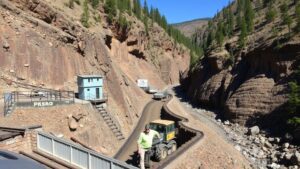Techniques for Managing Air Quality in Long Mining Tunnels
Techniques for Managing Air Quality in Long Mining Tunnels
Maintaining air quality in long mining tunnels is a crucial aspect of ensuring the health and safety of miners as well as the efficiency of operations. Poor air quality can lead to multiple problems including reduced worker productivity, increased risk of respiratory conditions, and potential hazards from explosive gases. Various techniques exist to mitigate these risks, and this article will explore them in detail.
Understanding Air Quality Challenges in Mining Tunnels
Long mining tunnels often present unique challenges related to air quality due to confined spaces and limited natural ventilation. Here are some common air quality issues faced in these environments:
- Accumulation of particulate matter (PM) from drilling and blasting operations.
- Presence of harmful gases such as carbon monoxide (CO), methane (CH4), and sulfur dioxide (SO2).
- Inadequate oxygen levels leading to worker fatigue and decreased operational capacity.
According to the World Health Organization, air pollution contributes to approximately 7 million premature deaths globally, underscoring the importance of effective air quality management in industrial settings.
Strategies for Enhancing Air Quality
There are several techniques and strategies that can be employed to improve air quality in long mining tunnels. These can be broadly categorized into engineering controls, administrative controls, and personal protective equipment (PPE).
1. Engineering Controls
Engineering controls involve physical modifications to the environment to reduce air quality hazards. Key methods include:
- Ventilation Systems: Appropriate ventilation designs, such as forced ventilation and exhaust systems, are critical. For example, one of the most effective systems in use is the jet fan system, which actively moves contaminated air out of the tunnel while introducing fresh air.
- Dust Suppression Techniques: Employing water sprays and dust suppressants can significantly reduce particulate matter. The application of water mist systems has been shown to decrease airborne dust levels by up to 90% in certain operational studies.
- Monitoring Equipment: Useing real-time air quality monitoring systems helps track levels of hazardous gases and particulates. Systems equipped with sensors can alert workers when thresholds exceed safety levels.
2. Administrative Controls
Administrative controls are policy-driven strategies designed to minimize exposure to air quality issues:
- Regular Training: Conducting routine training for workers on recognizing air quality hazards, understanding safe practices, and knowing emergency response protocols can significantly enhance safety culture.
- Work Scheduling: Adjusting work schedules to optimize airflow and minimize the time spent in high-risk areas can reduce potential exposure to poor air quality.
- Routine Inspections: Regularly scheduled inspections to assess and maintain ventilation and filtration systems are essential for effective air quality management.
3. Personal Protective Equipment (PPE)
While engineering and administrative controls are effective, personal protective equipment remains a vital last line of defense. This includes:
- Respirators: The use of respirators that filter out specific particulates and gases can protect miners from harmful exposures. For example, N95 respirators are effective in filtering out 95% of airborne particles.
- Protective Clothing: Specialized clothing can help protect workers from dust and chemical exposure, enhancing overall safety.
Case Studies and Real-World Applications
Examining real-world applications of air quality management techniques can provide valuable insights:
- Witwaterstrand Basin Project, South Africa: The implementation of state-of-the-art ventilation systems and regular air quality monitoring reduced CO levels by 60%, significantly improving miner safety.
- Glenwood Springs Tunnel, USA: The use of water mist suppressants resulted in a 75% decrease in airborne dust levels, directly correlating with improved miner health reports.
Actionable Takeaways
To effectively manage air quality in long mining tunnels, consider implementing the following strategies:
- Invest in advanced ventilation systems tailored to your specific mining environment.
- Conduct regular training sessions for all employees on air quality measures and risks.
- Use real-time monitoring tools to track air quality and respond proactively to hazards.
- Ensure that all personnel are equipped with the appropriate PPE for their specific tasks.
By prioritizing air quality management, mining operations can ensure a safer work environment, enhance productivity, and comply with health regulations.

